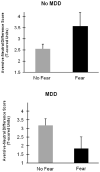Aversive startle potentiation and fear pathology: Mediating role of threat sensitivity and moderating impact of depression
- PMID: 25448265
- PMCID: PMC4422769
- DOI: 10.1016/j.ijpsycho.2014.10.014
Aversive startle potentiation and fear pathology: Mediating role of threat sensitivity and moderating impact of depression
Abstract
Enhanced startle reactivity during exposure to unpleasant cues (aversive startle potentiation; ASP) appears in the RDoC matrix as a physiological index of acute threat response. Increased ASP has been linked to focal fear disorders and to scale measures of dispositional fearfulness (i.e., threat sensitivity; THT+). However, some studies have reported reduced ASP for fear pathology accompanied by major depressive disorder (MDD) or pervasive distress. The current study evaluated whether (a) THT+ as indexed by reported dispositional fearfulness mediates the relationship between fear disorders (when unaccompanied by depression) and ASP, and (b) depression moderates relations of THT+ and fear disorders with ASP. Fear disorder participants without MDD showed enhanced ASP whereas those with MDD (or other distress conditions) showed evidence of reduced ASP. Continuous THT+ scores also predicted ASP, and this association: (a) was likewise moderated by depression/distress, and (b) accounted for the relationship between ASP and fear pathology without MDD. These findings point to a role for the RDoC construct of acute threat, operationalized dispositionally, in enhanced ASP shown by individuals with fear pathology unaccompanied by distress pathology.
Keywords: Anxiety disorders; Depression; Fear; Startle; Threat sensitivity.
Copyright © 2014 Elsevier B.V. All rights reserved.
Conflict of interest statement
Figures


Similar articles
-
Context and explicit threat cue modulation of the startle reflex: preliminary evidence of distinctions between adolescents with principal fear disorders versus distress disorders.Psychiatry Res. 2014 Jun 30;217(1-2):93-9. doi: 10.1016/j.psychres.2014.01.047. Epub 2014 Feb 5. Psychiatry Res. 2014. PMID: 24679992 Free PMC article.
-
Intolerance of uncertainty and startle potentiation in relation to different threat reinforcement rates.Int J Psychophysiol. 2016 Jan;99:79-84. doi: 10.1016/j.ijpsycho.2015.11.006. Epub 2015 Nov 18. Int J Psychophysiol. 2016. PMID: 26602838
-
Affective individual differences and startle reflex modulation.J Abnorm Psychol. 1991 Feb;100(1):5-13. doi: 10.1037//0021-843x.100.1.5. J Abnorm Psychol. 1991. PMID: 2005271
-
The impact of startle reactivity to unpredictable threat on the relation between bullying victimization and internalizing psychopathology.J Psychiatr Res. 2019 Dec;119:7-13. doi: 10.1016/j.jpsychires.2019.09.004. Epub 2019 Sep 6. J Psychiatr Res. 2019. PMID: 31520836 Free PMC article. Review.
-
The anxiety spectrum and the reflex physiology of defense: from circumscribed fear to broad distress.Depress Anxiety. 2012 Apr;29(4):264-81. doi: 10.1002/da.21891. Depress Anxiety. 2012. PMID: 22511362 Free PMC article. Review.
Cited by
-
Methodological issues in the use of individual brain measures to index trait liabilities: The example of noise-probe P3.Int J Psychophysiol. 2017 Jan;111:145-155. doi: 10.1016/j.ijpsycho.2016.11.012. Epub 2016 Nov 14. Int J Psychophysiol. 2017. PMID: 27856400 Free PMC article.
-
Six Years of Research on the National Institute of Mental Health's Research Domain Criteria (RDoC) Initiative: A Systematic Review.Front Cell Neurosci. 2017 Mar 3;11:46. doi: 10.3389/fncel.2017.00046. eCollection 2017. Front Cell Neurosci. 2017. PMID: 28316565 Free PMC article. Review.
-
Integrating sleep, neuroimaging, and computational approaches for precision psychiatry.Neuropsychopharmacology. 2020 Jan;45(1):192-204. doi: 10.1038/s41386-019-0483-8. Epub 2019 Aug 19. Neuropsychopharmacology. 2020. PMID: 31426055 Free PMC article. Review.
-
Interrelations Among Biologically Relevant Personality Traits, Emotion Regulation Strategies, and Clinical Symptoms.J Psychopathol Behav Assess. 2019 Dec;41(4):549-559. doi: 10.1007/s10862-018-9709-z. Epub 2018 Dec 3. J Psychopathol Behav Assess. 2019. PMID: 34290472 Free PMC article.
-
Linking RDoC and HiTOP: A new interface for advancing psychiatric nosology and neuroscience.Clin Psychol Rev. 2021 Jun;86:102025. doi: 10.1016/j.cpr.2021.102025. Epub 2021 Mar 24. Clin Psychol Rev. 2021. PMID: 33798996 Free PMC article. Review.
References
-
- Arrindell W, Emmelkamp P, Van der Ende J. Phobic dimensions: I. Reliability and generalizability across samples, gender and nations. Advances in Behaviour Research and Therapy. 1984;6:207–254.
-
- Bradley M, Codispoti MM, Cuthbert BN, Lang PJ. Emotion and motivation I: Defensive and appetitive reactions in picture processing. Emotion. 2001;1:276–298. - PubMed
-
- Blumenthal TD, Cuthbert BN, Filion DL, Hackley SA, Lipp OV, van Boxtel A. Committee report: Guidelines for human startle eyeblink electromyographic studies. Psychophysiology. 2005;42:1–15. - PubMed
-
- Buss AH, Plomin R. Temperament: Early developing personality traits. Hillsdale: Lawrence Erlbaum Associates; 1984.
-
- Center for the Study of Emotion and Attention (CSEA-NIMH) The International Affective Picture System: Digitized photographs. Gainesville, FL: The Center for Research in Psychophysiology, University of Florida; 1999.
Publication types
MeSH terms
Grants and funding
LinkOut - more resources
Full Text Sources
Other Literature Sources

